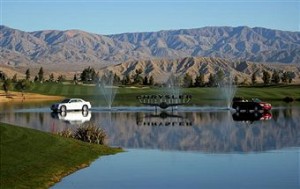We’ve all seen many, many Pro Am golf tournaments on television over the years; such as the AT&T at Pebble Beach and the five-day tournament at the Bob Hope Desert Classic in Palm Springs, both in California. What you see on television is just a smattering of some celebrity for maybe five seconds at a time. What we get to see are some gawd awful swings and their attempt at making the spectators laugh.
 Nothing can be further from the truth when you see them live on the golf course. At the Bob Hope Desert Classic, one pro is teamed up with three amateurs whose handicap ranges from zero to eighteen. The zero handicappers, of which there are very few, can keep up with the pros as far as driving distance is concerned, but they are not going to hit the greens regularly like the pros. The higher handicappers are generally twenty to forty yards back and quite often require three shots to get on some par four holes.
Nothing can be further from the truth when you see them live on the golf course. At the Bob Hope Desert Classic, one pro is teamed up with three amateurs whose handicap ranges from zero to eighteen. The zero handicappers, of which there are very few, can keep up with the pros as far as driving distance is concerned, but they are not going to hit the greens regularly like the pros. The higher handicappers are generally twenty to forty yards back and quite often require three shots to get on some par four holes.
One has to give the pros credit for being extremely patient as the golf round takes about five to five and a half hours to play (on our golf course, you get a citation if you take longer than four hours). The pro hits first from the long tee (usually black) and the amateurs play from the blue tees. The difference is not really that much…maybe twenty to thirty yards shorter. It would seem that they could have placed them on the “member’s” tee that would have shortened the hole another twenty yards or so. It is interesting to note that they all play “ready golf”, meaning that as soon as everyone hits, the group scatters in all directions, directly to his own ball. The pro stands on the edge of the fairway, alongside his ball and looks back about a zillion yards, patiently waiting for the amateurs to hit and hit again until he catches up to the pro’s ball.
More than frequently, one or two of the amateurs will be trotting up to the pros’ ball with his ball in pocket. He has picked up as he has used up more than his allotted strokes; meaning that on a par four, five strokes if he does not get a stroke, or six, if he gets a stroke. They can always count on his pro getting at least a par.
What separates the wheat from the chaff is the play around the greens. Whether it’s a second shot on a par five or a par four, when the pro hits, you needn’t worry about losing sight of the ball. All you have to do is watch the green and wait for the ball to land there. You seldom lose sight of the amateur’s ball because he’d invariably be making a short pitch/chip shot from nearby.
The first reaction we spectators have when watching these amateurs, in front of a huge crowd, flogging and struggling to keep up, is to wonder why they would want to do this. Well, I got to know one of these amateurs quite well…an 18 handicapper named John (surname omitted) who was on Mike Weir’s team that day. His wife who drove the cart for him is really the one I got to know quite well. I accused her of trying to run me over on the cart path, and promptly became really good friends. John’s sole occupation, as a sixty-two year old wannabe, is to follow the various Pro-Am tournaments across the United States. He loves the camaraderie, the association with a golf professional, and the crowd and atmosphere of a golf tournament. Most of all, he is happy to fork over the twelve thousand dollar entry fee, because, as he says, it is for a great cause. With the other two hundred and forty-eight amateurs contributing, the donation becomes a substantial amount. The greatest winner of these tournaments is, as they say, the Charity.
As a parting remark, I asked John “John I watched you golfing all day and I know you’re not an 18 handicapper and I know what they say about you guys…something about mucking around in the sand? Now tell me truthfully, what is your true handicap?” Without batting an eye, he says “I’m a fifteen”. “Now come on, John” I say “you’re no more than a twelve!” He has a silly grin on his face as he turns to look at his wife.
The winning amateur team was minus forty-seven for the three days. Because the team changes pro every day, let’s say the average pro’s score was eleven for the three days. That would leave thirty-six under for fifty-four holes of play. Not a bad effort for a bunch of amateurs!
